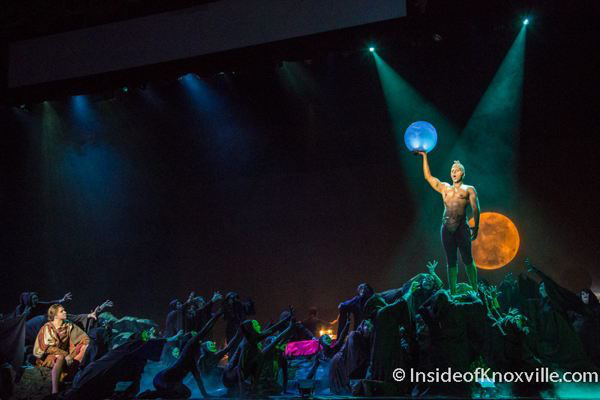Knoxville Opera’s production of Boito’s Mefistofele
Tennessee Theatre
Friday, October 9, and Sunday, October 11
Unless you have been in the vicinity of a major opera house—like the Metropolitan Opera in New York, San Francisco Opera, or some of the oft-visited ones in Europe like the State Opera in Prague—and at just the right time, you’ve probably never seen a production of Boito’s Mefistofele. It was said that Knoxville Opera’s production that opened on Friday is the first for the state of Tennessee. I certainly do not doubt that. But for that reason among several, it was important to catch this one. One performance remains: Sunday matinee at 2:30 p.m. at the Tennessee Theatre.
Mefistofele, based on the Faust literary legend and inspired by Goethe’s Faust, is the only opera finished and performed during the lifetime of Boito, a composer who was principally known as a librettist for Verdi’s last masterpieces, Otello and Falstaff. In fact, the brilliance of Boito as a librettist is wonderfully obvious in the poetry that is Mefistofele. Sadly, and not surprisingly, Boito’s score is not an equal partner to that poetry, and except for a few notable and gorgeous examples, is quite forgettable. For that reason, opera companies have seized on the visual spectacle opportunities and have chosen to dazzle our eyes. Knoxville Opera’s hugely entertaining production does just that, winning us over with luscious stage pictures and choral and orchestral sound on a monumental scale.
Maestro Brian Salesky and stage director Brian Deedrick have created a distinctive production by mixing visual twists with the impression of a Tennessee Theatre stage packed with 130 or so singers and an almost full sized orchestra. They achieved this look by placing the orchestra on stage behind a scrim and using the elevator-driven stage apron—normally the orchestra pit in the ‘down’ position—to facilitate scene changes. The result is a kinetic element that actually allows the necessary minimal scenic treatment to work beautifully.
Essential as well to the success of the opera is an engaging and appropriately enticing bass-baritone for the role of Mefistofele—something that Salesky found in a powerfully voiced Donovan Singletary. The singer has an incredibly gym-chiseled body which turned out for many to be an ironic metaphor for temptation.
The biggest surprise of this production, though, was soprano Julia Lima in the role of Margherita. Lima’s dramatic performance arc ran impressively from naïve village girl to death scene penitence. That final aria in which she tells of her insanity and impending death, “L’altra notte in fondo al mare,” was simply stunning. Since her last appearance with Knoxville Opera in Die Fledermaus several seasons ago, Lima has found a gorgeous depth for her voice and an at-ease clarity that works well for characterizations of subtlety and strength.
Tenor Cody Austin made a handsome younger Faust, although I found the older character’s beard and wig to look seriously obvious and contrived. Austin had a few issues with his higher notes in Act I, but delivered an impressive finale death scene, both dramatically and vocally.
By cutting a couple of non-essential scenes, including the oft-excised Helen of Troy scene, Salesky also eliminated a few roles. In the two remaining secondary roles were seriously impressive performances by Ryan Ford, as Faust’s assistant, Wagner, and Allison Deady as Marta, a villager enamored of Mefistofele.
The impact of production scale was most apparent, and delicious, in three key places—the Prologue, the Witches’ Sabbath scene, and the Epilogue. A partner in this regard was lighting designer John Horner who succeeded in keeping visibility focused and dramatically dark when appropriate, as well as letting the kinetics of projection and moving light communicate depth.
Much of this scale, too, came from the 130+ singers that filled the stage, either as a choral ensemble or in the opera’s group scenes. The groups making up this mass of humanity was the Knoxville Opera Chorus, the Knoxville Chamber Chorale, Pellissippi State Variations Ensemble, the Knoxville Opera Youth Choir, and Ballet Gloria.
Given the intricacies of staging, Salesky managed to keep a miraculous balance in the music forces (aided by some judicious amplification) in what may have been one of the more intriguing tasks asked of the Knoxville Symphony Orchestra in some time. But, based on Knoxville Opera’s schedule this season of Hansel und Gretel and Tosca, this may only be the start.






